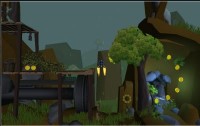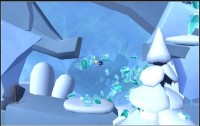

Bob Came in Pieces is an indie game developed by Swedish developer Ludosity Interactive. It stars Bob; an average run-of-the-mill alien call center employee. On his way to work one day his ship gets struck by a meteor and he crash lands on an uninhabited planet. To escape this doom, Bob must find the pieces of his ship and reassemble them.

The major hook of this game are the physics-based puzzles. As you find new pieces of your ship, you can customize it however you like. Bob’s ship has a total of eight basic slots, in each of these slots you can put basically whatever part you’d like. There are a large variety of pipes or arms you can attach to these slots, allowing you to create more complex structures and helping you to direct your tools. For every puzzle there is a different ship design needed to solve it, and while a certain amount of leeway is given, often a specific design is best. The nature of the puzzle and environment around it will give you fairly obvious clues as to which way to design your ship. Prepare for a fair bit of hassle though, for although the puzzles themselves aren’t too hard. The controls are.
More time will be spent hassling with the nature of the physics system then solving the actual puzzles. For every part you add to the ship the center of gravity is put out of balance – unless, of course, you keep the ship perfectly symmetric. To make up for this lack of balance the player is asked to wrestle with the controls. And since most puzzles don’t allow for a symmetric ship design, or you often won’t have enough duplicate parts. This is a constant problem. It is part of the puzzle, true, but it causes much more frustration than fun. The brain isn’t what’s forced to work here, but rather your joint muscles.
As you find more pieces, more tools will be made available; new and more powerful rocket-motors to combat the increasing weight of your ship and repulsive and attractive beams to move objects. And that’s it. The ship itself can also be used to move or break objects and obstacles, given enough momentum. After the first few initial levels these tools will mostly be what’s used to solve puzzles, it’s never a question what tool should be used for which job. Any element of experimentation the game might have worked will with is therefore more or less removed.

There are 14 levels, all of which are relatively long with nice little secrets for completionists to find. These levels include the standard underground, forest and snow levels gamers have come to love. It is, for the most part, a nice looking game. While the art style is anything by original, it has a certain feeling of serenity that is most welcoming. The game also features music and sound effects, but that’s really all that can be said for it; nothing noteworthy. All in all the presentation is better than most games in its class, but with all respect; that isn’t saying much.
It’s hard to say how long the game lasts, as it all depends on how long it takes you to figure out each puzzle. Personally, I got about one and a half hour’s worth of play out of it, at most. That’s not bad for a $10 game. But I’d be lying if I wouldn’t rather be playing some other more entertaining $10 game instead. When it comes down to it, it’s a clever concept that just doesn’t work. The puzzles are too easy, the controls are horrible and it’s just not fun enough to make up for all that. Don’t Bother.
